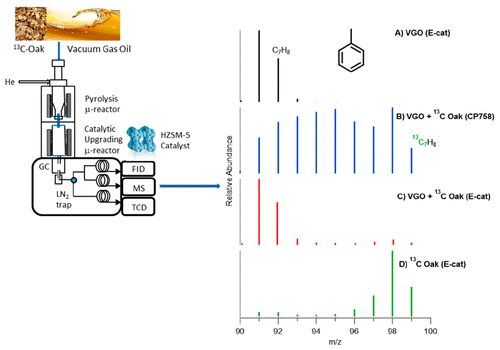当前位置:
X-MOL 学术
›
ACS Sustain. Chem. Eng.
›
论文详情
Our official English website, www.x-mol.net, welcomes your feedback! (Note: you will need to create a separate account there.)
Isotopic Studies for Tracking Biogenic Carbon during Co-processing of Biomass and Vacuum Gas Oil
ACS Sustainable Chemistry & Engineering ( IF 8.4 ) Pub Date : 2020-02-03 , DOI: 10.1021/acssuschemeng.9b05762 Calvin Mukarakate 1 , Kellene Orton 1 , Yeonjoon Kim 1 , Stefano Dell’Orco 2 , Carrie A. Farberow 1 , Seonah Kim 1 , Michael J. Watson 3 , Robert M. Baldwin 1 , Kimberly A. Magrini 1
ACS Sustainable Chemistry & Engineering ( IF 8.4 ) Pub Date : 2020-02-03 , DOI: 10.1021/acssuschemeng.9b05762 Calvin Mukarakate 1 , Kellene Orton 1 , Yeonjoon Kim 1 , Stefano Dell’Orco 2 , Carrie A. Farberow 1 , Seonah Kim 1 , Michael J. Watson 3 , Robert M. Baldwin 1 , Kimberly A. Magrini 1
Affiliation

|
Co-processing bio-oils with petroleum-derived feeds in the existing multitrillion dollar refining and distribution infrastructure is an attractive option for introducing renewable energy into the fuels marketplace. Considerable research on co-processing bio-oils and vacuum gas oil (VGO) in fluid catalytic cracking units (FCC) using equilibrium catalysts (E-Cats) demonstrated that biomass-derived molecules decreased activity of and increased carbon laydown on E-Cat. In this work, 13C-labeled biomass was co-processed with VGO using either an E-Cat or a proprietary zeolite Johnson Matthey catalyst (CP758), which is optimzed for upgrading biomass vapors in a riser reactor, to evaluate the fate of biogenic carbon in FCC products. The results from both catalysts indicate that biogenic carbon was incorporated into alkenes and aromatic hydrocarbons. While no biogenic carbon was found in linear alkanes, it was observed in cycloalkanes during experiments with E-Cat but not with CP758. All produced CO2 was biogenic as was most of the carbon laydown on the catalysts. Several partially deoxygenated biomass compounds, such as alkylphenols and benzofurans, unexpectedly contained small amounts of carbon from VGO. Although this study was conducted with labeled biomass and not bio-oil, it provides insights to reaction mechanisms for co-processing bio-oil and VGO in an FCC, which is required to develop catalysts that efficiently convert bio-oil components during FCC co-processing. This work also demonstrates that comprehensive catalyst development utilizing both biomass- and fossil-derived feeds is required to maximize the incorporation of biogenic carbon into transportation fuels.
中文翻译:

生物质和真空瓦斯油共处理过程中跟踪生物碳的同位素研究
在现有的数万亿美元的炼油和分销基础设施中,将生物油与石油衍生的原料进行共处理是将可再生能源引入燃料市场的诱人选择。使用平衡催化剂(E-Cats)在流化催化裂化装置(FCC)中对生物油和真空瓦斯油(VGO)进行共处理的大量研究表明,生物质衍生的分子会降低E-Cat的活性并增加其碳沉积量。在这项工作中,13使用E-Cat或专用的Johnson Johnson Matthey沸石催化剂(CP758)将C标记的生物质与VGO进行共处理,这种催化剂经过优化可提升提升管反应器中的生物质蒸气,以评估FCC产品中生物碳的结局。两种催化剂的结果均表明,生物碳已掺入烯烃和芳烃中。虽然在直链烷烃中未发现任何生物碳,但在使用E-Cat(但不是用CP758)进行的实验中,在环烷烃中观察到了。全部产生CO 2与大多数催化剂上的碳沉积一样,具有生物成因。几种部分脱氧的生物质化合物,例如烷基酚和苯并呋喃,出乎意料地包含来自VGO的少量碳。尽管这项研究是针对标记的生物质而非生物油进行的,但它为在FCC中共同处理生物油和VGO的反应机理提供了见解,而开发在FCC混合过程中有效转化生物油成分的催化剂是必需的处理。这项工作还表明,需要利用生物质和化石衍生的原料进行全面的催化剂开发,以最大程度地将生物碳整合到运输燃料中。
更新日期:2020-02-03
中文翻译:

生物质和真空瓦斯油共处理过程中跟踪生物碳的同位素研究
在现有的数万亿美元的炼油和分销基础设施中,将生物油与石油衍生的原料进行共处理是将可再生能源引入燃料市场的诱人选择。使用平衡催化剂(E-Cats)在流化催化裂化装置(FCC)中对生物油和真空瓦斯油(VGO)进行共处理的大量研究表明,生物质衍生的分子会降低E-Cat的活性并增加其碳沉积量。在这项工作中,13使用E-Cat或专用的Johnson Johnson Matthey沸石催化剂(CP758)将C标记的生物质与VGO进行共处理,这种催化剂经过优化可提升提升管反应器中的生物质蒸气,以评估FCC产品中生物碳的结局。两种催化剂的结果均表明,生物碳已掺入烯烃和芳烃中。虽然在直链烷烃中未发现任何生物碳,但在使用E-Cat(但不是用CP758)进行的实验中,在环烷烃中观察到了。全部产生CO 2与大多数催化剂上的碳沉积一样,具有生物成因。几种部分脱氧的生物质化合物,例如烷基酚和苯并呋喃,出乎意料地包含来自VGO的少量碳。尽管这项研究是针对标记的生物质而非生物油进行的,但它为在FCC中共同处理生物油和VGO的反应机理提供了见解,而开发在FCC混合过程中有效转化生物油成分的催化剂是必需的处理。这项工作还表明,需要利用生物质和化石衍生的原料进行全面的催化剂开发,以最大程度地将生物碳整合到运输燃料中。


























 京公网安备 11010802027423号
京公网安备 11010802027423号